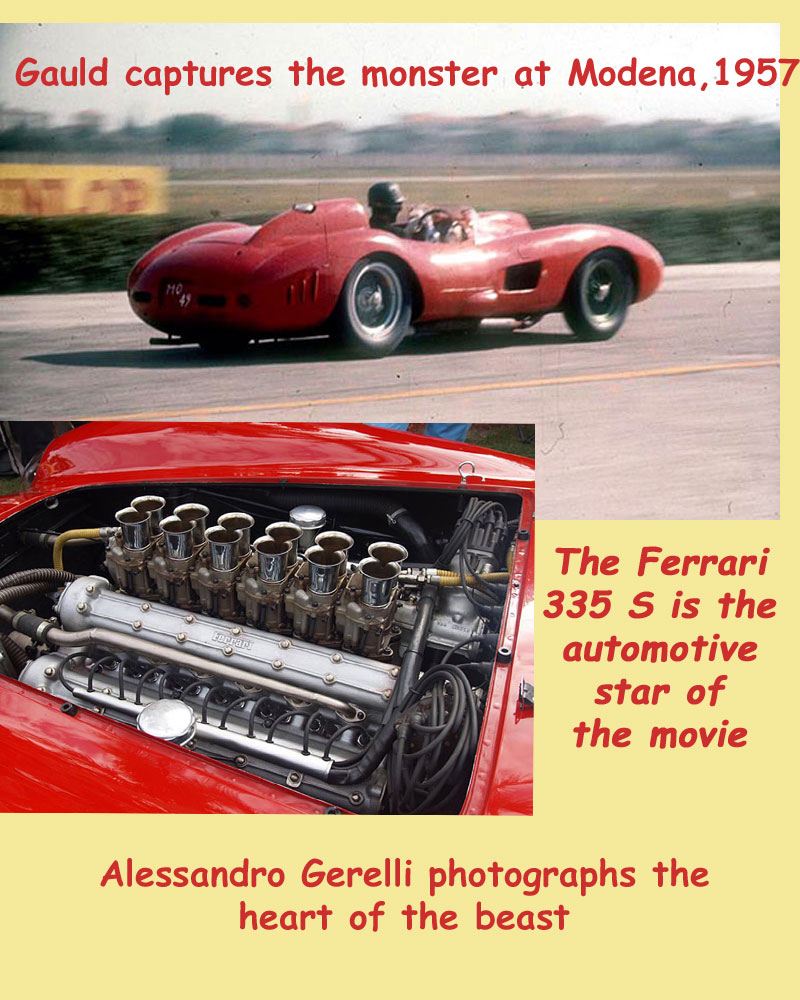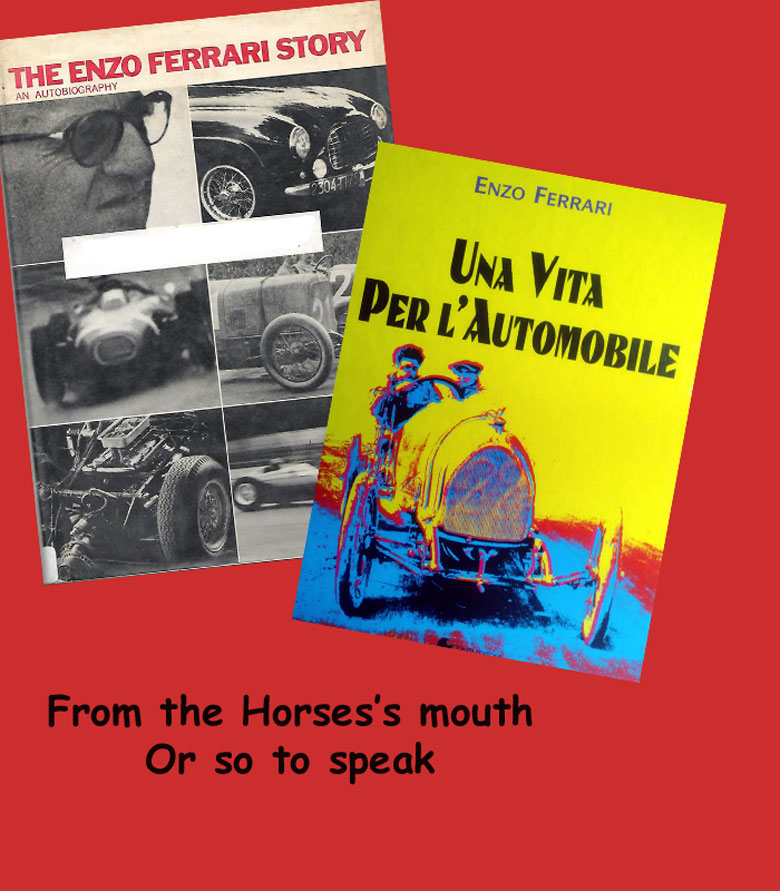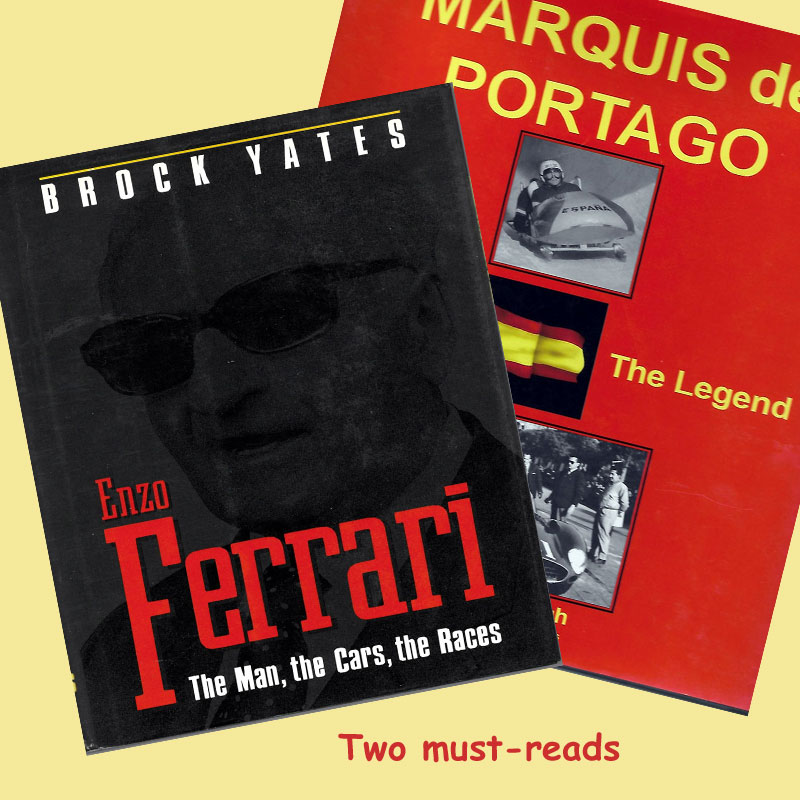By Pete Vack
Hollywood strikes again. Your friends will ask, was it really like this? You will be amused. Or you will not be amused. But it is coming. Deal with it.
Remember when Ford vs Ferrari came out? In those pre-pandemic days, seems like all of your friends and relatives went to see it in the theaters. Then they called or sent you a message or even visited you and asked you, you being the expert on all things foreign and Ferrari, a bunch of questions. Did you know Shelby, what was he like, or was he like Matt Damon, did Miles and Shelby really have a fight, was it really a close finish at Le Mans, why did Ferrari lose etcetera, etcetera.
Hollywood got it close to right and it was a great film. But Ferrari, the movie which will be in theaters around Christmas, is darker, with more conjecture, and like the book on which it is based, may be less accurate than one might wish. And more truthful and less comfortable. And will it hurt Ferrari’s image?
Then, below, Wally Wyss takes a look at the reviews and tells us how the film was made and how the reviews have fared so far. Note that neither one of us has seen the movie, but Penelope Cruz as Laura Ferrari?
My Terrible Joys
In 1962 or thereabouts Enzo Ferrari wrote a short autobiography, aptly titled in Italian Le Mie Gioie Terribili or My Terrible Joys. We have the English translation entitled The Enzo Ferrari Story published by MacMillian in 1964. With the last Mille Miglia still on his mind, Ferrari answers many questions about his role in that tragic Mille Miglia, and it is straight from the horse’s mouth, so to speak. Which makes this closer to home than many of the fine biographies out there. Did Ferrari ever apologize for the deaths of those innocent spectators? Have the answer ready for your friends.
Una Vita Per l’ Automobile
This was a book compiled by the Ferrari family after Enzo’s death. Each photo is accompanied by an appropriate quote by Enzo Ferrari. It is telling. While there are only a couple of photos of a very young Laura Ferrari, there are many of Lina Lardi, his mistress whom he had known since 1929. This book, published by Conti Editore in 1998, provides many insights into Ferrari’s personal life.
Marquis de Portago, The Legend
You’ll want to brush up on the short, full life of Alfonso de Portago. One of the best ways of doing that is to find a copy of Ed McDonough’s biography published by Mercian Manuals Ltd in 2006. Ed had access to the family albums and spent time with Portago’s first and only wife. It’s all here, the bobsledding, the women, the Kiss of Death, details of the accident and the funeral. Everything about the crash your friends will want to know.
Enzo Ferrari The Man, the Cars, the Races
A flawed first edition, poorly edited, as unfinished as a racing prototype, Yates’ first book on Ferrari, published by Doubleday in 1991, is nonetheless exciting, riveting and gets away from the hagiographies which litter the shelves. Ferrari fans hated it, and it seems that the truth according to Yates hurt. But great material for a movie. Wyss explains below how Yates hit the big screen once again, posthumously. Find a copy before the movie comes out. Read it with caution, noting that it is poorly documented. Apparently, a later edition of the book was more properly edited. Enzo probably wouldn’t have liked Yates anyway. “There’s nothing to be done about interviewers,” he was quoted in Una Vita Per l’ Automobile. “They mostly come to you with their preconceived ideas, the women even worse than the men, and there’s absolutely no point in trying to change their minds.”
And above it all, when thinking of Enzo Ferrari, consider this quote when describing his feelings when meeting with the Shah of Iran and the King of Belgium: “I am flattered by such marks of respect but they make me feel slightly uncomfortable. I feel more at ease when I’m busying myself about the workshop and chatting to my mechanics. It is becoming increasingly difficult to remain what I really feel I am: a provincial craftsman.” (Una Vita Per l’ Automobile)
Take that, Hollywood!
Getting Ferrari off the Ground
By Wallace Wyss
It can take a long time for a director to get a film off the ground. But Michael Mann finally succeeded with his biopic Ferrari, premiering it in Venice in late August. A teaser trailer was released August 30th. The intense 90-second trailer to the full-length movie varies from office and home scenes to full bore racing and even a fiery crash.
NEON, producers of the new film, provided this synopsis for Ferrari: “It is the summer of 1957. Behind the spectacle of Formula 1, ex-racer Enzo Ferrari is in crisis. Bankruptcy threatens the factory he and his wife, Laura built from nothing ten years earlier. Their volatile marriage has been battered by the loss of their son, Dino a year earlier. Ferrari struggles to acknowledge his son Piero with Lina Lardi. Meanwhile, his drivers’ passion to win pushes them to the edge as they launch into the treacherous 1,000-mile race across Italy, the Mille Miglia.”
The key race in the film is not Le Mans as in Ford v. Ferrari, but almost a decade earlier; the 1957 Mille Miglia, a race followed by a legal battle that you could say ended that race forever(Ferrari had made the car that malfunctioned and was held responsible for multiple deaths).
The story is based on a biography written in 1991 by the “bad boy” journalist of Car and Driver Brock Yates, whose Enzo Ferrari — The Man, The Cars, The Races, The Machine came out in 1991. Yates was a pit reporter for NASCAR on CBS and the host of the TNN racing show American Sports Cavalcade and a bit infamous for his creation of the famous Cannonball Run race, a coast-to-coast rally starting from New York and finishing in Los Angeles. An action comedy film of the same name was produced, which Yates also wrote. The screenplay for Ferrari was by Troy Kennedy Martin.
In an interview with Variety some time before filming it, Mann made it clear that viewers could expect the film will be more violent than American audiences are used to, as it will feature at least one crash involving considerable gore. Ford v. Ferrari, in retrospect, might be looked at retrospectively as timid by comparison (Ken Miles’ death was depicted long distance, done off camera).
Mann has wanted to make this movie for a long time, first exploring the idea around 2000, having first discussed the project with Sydney Pollack.
According to Variety, the idea of making a bio of Enzo Ferrari originated with Italy’s storied Cecchi Gori Group before the company went bust.
Said Variety: “In 1991, Los Angeles-based Penta Pictures — which had been jointly founded by producer Vittorio Cecchi Gori and then-rising TV mogul Silvio Berlusconi — bought adaptation rights to the book Enzo Ferrari: The Man, the Cars, the Races by Brock Yates that is the basis for Mann’s picture. Cecchi Gori subsequently hired Troy Kennedy Martin to write the script and when Penta Pictures was dissolved in 1995 the ‘Ferrari’ rights went to its U.S. arm, Cecchi Gori Pictures.”
Then the project lay fallow until 2004, when Sydney Pollack was named to direct it, with Al Pacino playing the lead. Meanwhile back in Italy, in 2006 Cecchi Gori Group went belly up and Vittorio Cecchi Gori went into soccer. Salvaged was Troy Kennedy Martin’s script based on Brock’s book. The option had expired, Brock had died but the option was renewed with Brock’s widow.
Mann, showed renewed interest in 2010, with an eye toward having Christian Bale play the lead. But Bail bailed out in 2016. But the financing came and a new lead was cast. The movie was shot on location around Maranello.
Though we haven’t yet seen the movie, Mann seems intent on showing there’s obsession in all racing, but that mindset was particularly and painfully obvious in Europe during that mid-’50s era. For Ferrari team racers, their fellow racers were dying all around them. We won’t know until we see it how much the film blames Ferrari himself for setting up the situation where his drivers were tempted to drive beyond their ability in order to stay on the team but one thing’s sure–audiences can expect a more brutal interpretation of racing than has been seen in American film for a long time. You might even say it’s a film about coping with grief with some racing scenes thrown in.
Casting
The lead is played by an almost unrecognizable Adam Driver, best known for playing Kylo Ren/Ben Solo, in the Star Wars sequel trilogy. For Ferrari’s wife, Laura, Mann cast Penélope Cruz, an Academy Award winner got the role.
Of course, Enzo had a mistress, mother of Piero, and there’s a key role for her character in the film, played by Shailene Woodley.
A lot of Hollywood actors with real world racing experience were champing at the bit to be in the film, and a Hollywood leading man, Patrick Dempsey, is cast as Italian race car driver Piero Taruffi. Dempsey is no stranger to racing.
The film competed for the Golden Lion at the 80th Venice International Film Festival, where it premiered on August 31, 2023. It is scheduled to be released in the US on Christmas Day.
AUTHOR: Wyss has his own Ferrari book, a novel, Ferrari Hunters, aimed at Hollywood. He can be reached at malibucarart@gmail.com
Lead Photo by Graham Gauld: A sunny day at the Modena Autodrome nearly fifty nine years ago. Ferrari appeared with the 335S (0674) to test the Dunlop tires. Test driver Martino Severi at the wheel. This same car sold at Retromobile for $35.7 million.



Oh, boy… If The Dragon Lady, as some former Ferrari empolyees referred to Laura, had EVER looked anything like Penelope Cruz, the old man would have been unlikely to chase down a mistress. And those former employees might have been more forgiving…MIGHT, but no guarantee, as actions overwhelm appearance. Maybe not with Ms Cruz.
With all due respect, I found Ford vs Ferrari, yes friends who had no interest in motor racing went to see it, typical Hollywood fare. Which is to say as a movie about LeMans I found it rather poor. Steve McQueen’s version even with the Hollywood theatrics much better. It will be interesting to see the extent to which Ferrari captures the racing of the late 50s (and 60s).
There are two explanations for the Guidizzolo tragedy.
In his autobiography, Enzo Ferrari puts the blame on the so-called cat-heads marking the middle of the road, damaging the front tire of the car, and causing its eventual puncture.
In an interview with Motorsport Magazine published in April 2018, former Jaguar mechanic Ron Gaudion said he had observed the Ferrari’s last refueling stop near Bologna, and rims were bent so that the car was shaking.
Portago refused to have them replaced and the rest is history.
Portago was known for his daredevil lifestyle and his way of driving around the Nürburgring scared none other than his passenger Phil Hill.
We can’t rewrite history but try to understand without modern prejudices the mindset of the period when there were neither safety belts nor tire pressure sensors or anything aiming at securing the drivers, their co-drivers, and the public.
Let’s wait and see how the film tells the story.
The 335S is my all time favorite 1950’s era Ferrari Sports Racing car.
Forza Ferrari!!
Well I am very pleased to be seen as an essential reference. I expect nevertheless that the film will be a long way from reality. We will see. Brock Yates had the right idea in being skeptical about Ferrari but perhaps didn’t provide evidence. Much of the material allegedly written by Ferrari was ghost written and I think his real opinions are little known. I stick by my account of the MM crash.